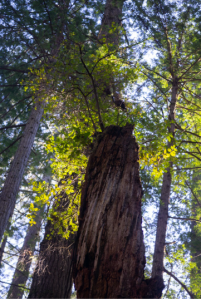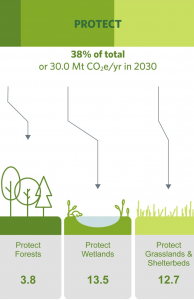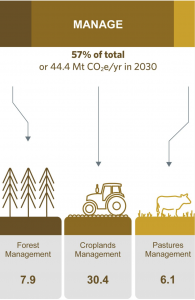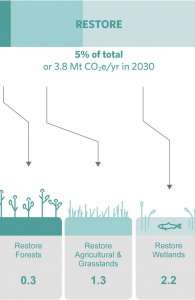Nurturing nature – an undervalued climate solution that goes beyond carbon
By Lucy Harrington, WEN Guest Blogger
I’m willing to guess that many of us mentally shortcut ‘trees = good’ and ‘no trees = bad’ when we think about solutions to the climate crisis. This simplification could benefit from being unpacked. How exactly do trees help fight climate change? Let’s dive into how nature can be a climate opportunity (as well as a liability), the concept of ‘natural climate solutions’, and how prioritizing nature benefits people and the planet.
Storing carbon in nature – an opportunity and a liability

Photo credit: Lucy Harrington
Through the cycle of carbon flowing in and out of living things, nature can both draw down carbon from the atmosphere, as well as release it. For example, a tree uses CO2 to form its trunk, branches, roots, and leaves. When the tree dies, it decomposes on the forest floor and soil microbes release CO2 back into the atmosphere. The leaf litter, tree roots, and other dissolved carbon of the forest are deposited in the soil.
Gathering CO2 from the atmosphere and storing it in leaves, roots, soil, and sediment is ubiquitous in nature. Croplands, grasslands, and wetlands (i.e., mangrove forests, peatlands, seagrass beds, and salt marshes) all store carbon through the beauty of the carbon cycle.
However, when a landscape is disturbed (e.g., a forest cleared for logging, a salt marsh drained for coastal development, or agricultural soil degraded), it loses the carbon it was storing to the atmosphere, becoming a carbon ‘source’ of emissions. Thus, the landscape becomes a liability in our fight against climate change.
Nature’s pathway for climate mitigation
The question is – how do we protect or enhance these natural landscapes as vessels to store carbon rather than release it? Introducing… natural climate solutions. Natural climate solutions, as defined by The Nature Conservancy, are conservation, restoration and improved land management actions that increase carbon storage or avoid greenhouse gas emissions in landscapes and wetlands across the globe. There are three key ways to keep or enhance carbon storage in nature:
- Protect: Conserve natural forests, wetlands, and grasslands from being converted to other land-uses, such as agriculture or bioenergy
- Manage: Manage our landscapes to be more effective at storing carbon through practices such as improved crop and grazing land management (e.g., farming practices that enhance carbon storage in the soil such as planting cover crops) and sustainable forest management
- Restore: Restore forests, wetlands, and degraded land through initiating and supporting new growth and overall ecosystem health
To be successful and just, natural climate solutions must center Indigenous and local knowledge and leadership. Worldwide, there are accounts of protected areas and afforestation efforts (forest plantations) pushing Indigenous and local communities off the land and/or preventing them from accessing the resources. Natural climate solutions must be designed and implemented with Indigenous communities’ consent, participation, and leadership.
Nature’s benefits beyond carbon
The benefits of protecting, restoring, and effectively managing these systems extend beyond climate change mitigation. Fostering ecosystems can support biodiversity, air and water filtration, flood control, soil health, as well as economic and community benefits. For example, wetlands provide a buffer against storm waves, tidal surges, and rising sea levels, protecting vulnerable coastal communities. Preventing deforestation can curb biodiversity loss and urban tree planting can cool hot city streets. Regenerative agriculture management practices, such as rebuilding the organic matter in soil and biodiversity, improves the overall health of the landscape and can reduce the need for chemical-based pesticides and fertilizers.
Benefits extend to women’s health as well. As noted by the United Nations Framework Convention on Climate Change (UNFCCC), women, especially those in poverty, face higher risks and experience a greater burden of climate change impacts. For example, globally, women suffer from higher rates of anemia and malnutrition due to increased nutritional needs during menstruation and pregnancy, making them more sensitive to climate-driven food insecurity. Restoring degraded land and investing in sustainable and resilient agricultural practices can support food security. The co-benefits of natural climate solutions are truly countless, but are all critical to the health of people and the planet.



A graphic illustrating the framework of natural climate solutions. © Nature United
Nature is under prioritized in the fight against climate change
Despite accounting for an estimated third of the cost-effective climate change mitigation potential needed by 2030, natural climate solution efforts receive less than 3% of all global climate funding. Rather than relying on unproven and expensive removal technologies such as carbon capture and storage, we need to ramp up our investment in nature.
Recently, there have been policy attempts for natural climate solutions that have not yet been put into action. Locally, in California, the Natural Carbon Sequestration and Resilience Act of 2022 (Assembly Bill 2649) is proposed to be the first statutory target for sequestering carbon on California’s natural, urban, and working lands. A recent report from the Climate Center found that California’s lands have the potential to capture up to 100 million metric tons of past climate pollution from the atmosphere per year – roughly equivalent to a quarter of the state’s annual emissions. As of June 2022, the bill has cleared the assembly floor and is headed to the senate. To support this bill, you can send a message to your representative here.
The recent United Nations IPCC report emphasized that we need to do more than cut emissions; we need to remove atmospheric carbon for any hope of avoiding the most catastrophic effects of climate change above the 1.5°C threshold. Natural climate solutions offer the most fruitful pathway to climate change mitigation by tackling parallel crises, such as biodiversity loss and land degradation, at the same time as benefiting people. The health of all people, especially those that are marginalized, are inextricably linked to the health of our planet. As pressure on our landscapes increases from the impacts of climate change and the growing demands of society, nurturing nature will become even more important.
Bio: Lucy Harrington is gainfully unemployed, living in a van, rock climbing, and taking time to enjoy the natural world. She is passionate about climate change action, nature-based climate solutions, and promoting equity. She recently worked as a research analyst at the sustainability consultancy, GlobeScan, in San Francisco. Feel free to reach out to her to connect, discuss a blog post, or just chat on LinkedIn.
